Beginnings are always hard. The same goes for writing a cover letter. You know exactly what you want to say, but you’re not sure how to start a cover letter.
Generally speaking, the cover letter intro is a place where you should:
- introduce yourself in detail
- explain why the job is exciting for you
- show you’re a great fit for the position
Of course, there’s no single right way to do it. That means that you’ve got multiple options and can get a little creative.
Whether you’re looking for a traditional cover letter introduction, or something more unconventional, you’ll find it in this article — together with a quick guide and cover letter openings examples.
Alternatively, you can also just watch this quick video guide on how to write a cover letter below.
Successful cover letter introductions (examples)
We’ve gathered some really good opening lines from successful cover letters that got people hired in well-known companies such as HubSpot, Siemens, or Lush:
HubSpot Director of Business Development Cover Letter Sample
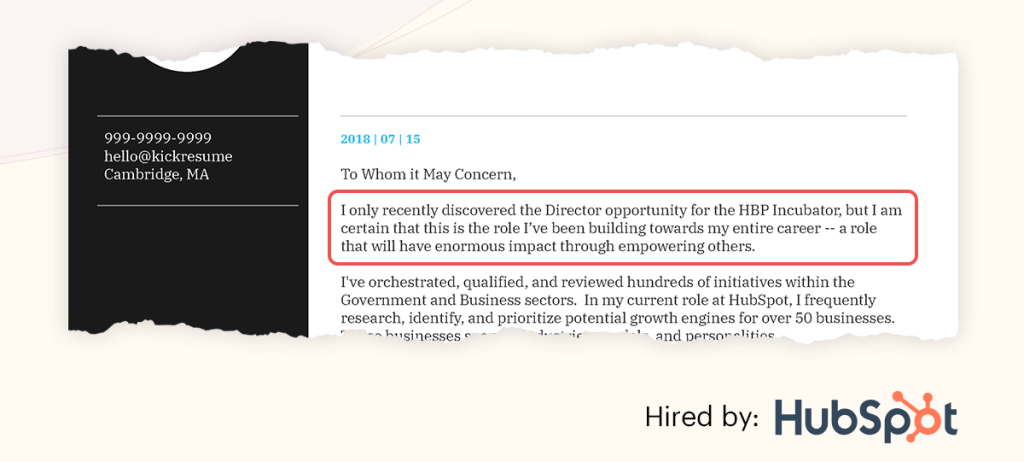
Account Executive Cover Letter Intro Sample
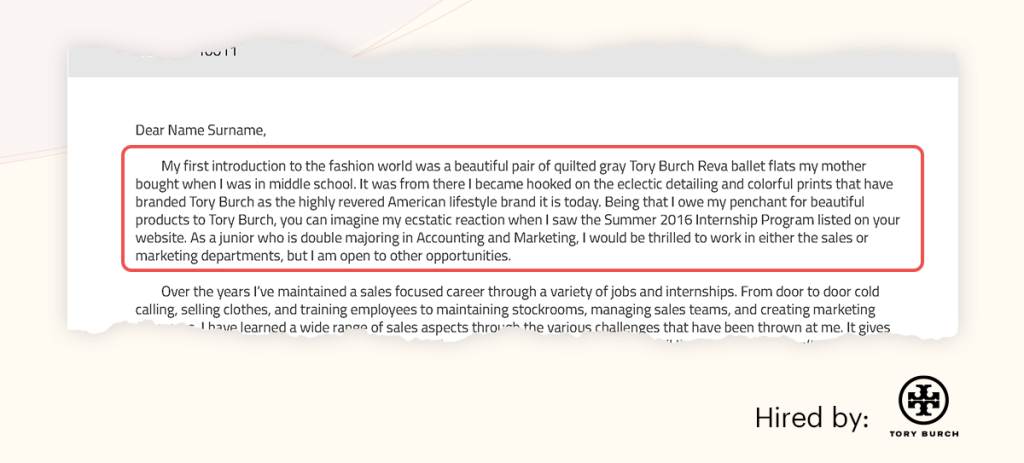
Sales Associate at LUSH Cover Letter Intro Example
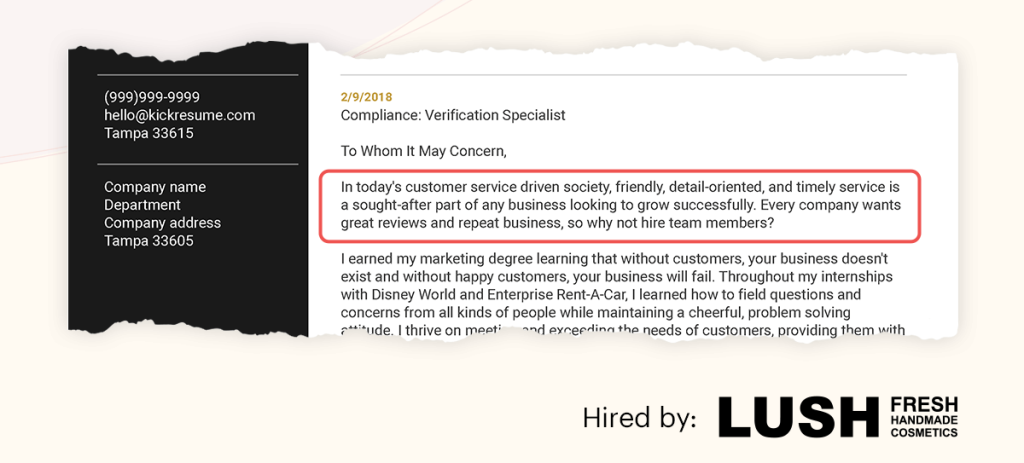
Siemens SCADA Engineer Cover Letter Intro Template
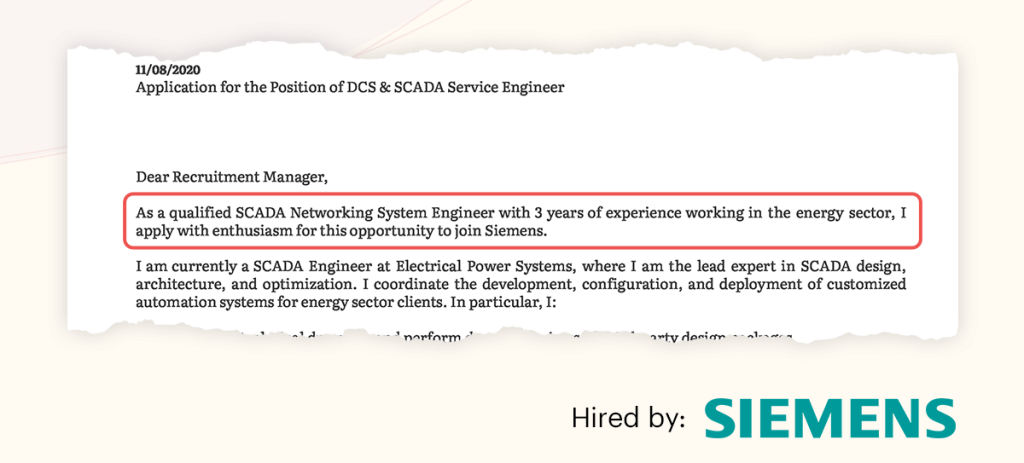
Warner Bros. Public Relations Intern Cover Letter Example
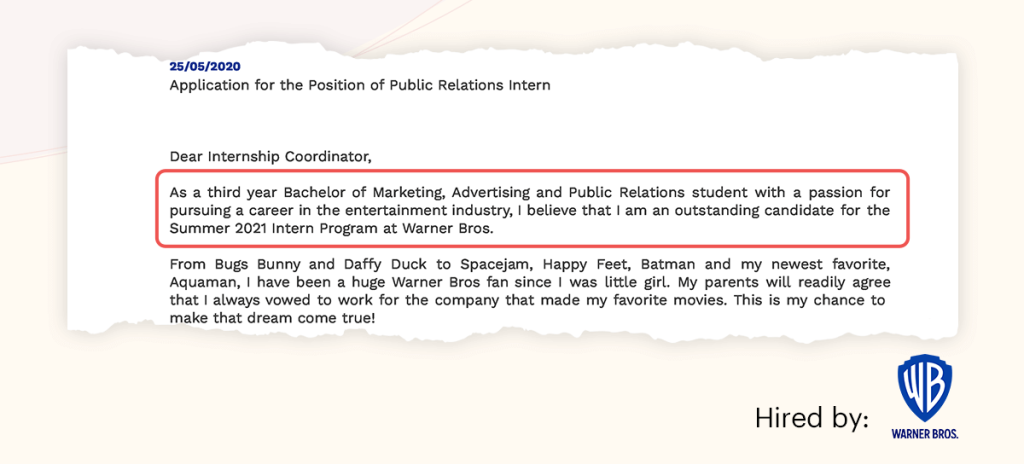
Do you want to know how to craft such a strong cover letter opening yourself? Follow a quick guide below.
And if you prefer to see more examples from hired professionals or find a job-specific cover letter example for your industry, visit our cover letter library .
Intro paragraph: a quick guide on how to start a cover letter
When it comes to cover letter openings, rule number one is that you should always start your cover letter in a way that grabs a recruiter’s attention from the get go.
On the other hand, be careful and stay professional. Don’t overdo it.
So the question is —when should you pick a standard opening paragraph and when to go with something more creative?
Well, it all depends on a particular job and the company culture.
Take time to research each company where you’re applying for a job and identify its tone of voice.
Are they formal or casual? Look at the job description, their website, and social media accounts and you’ll be able to get the right idea.
Then in your cover letter opening, follow at least one of these 7 main principles:
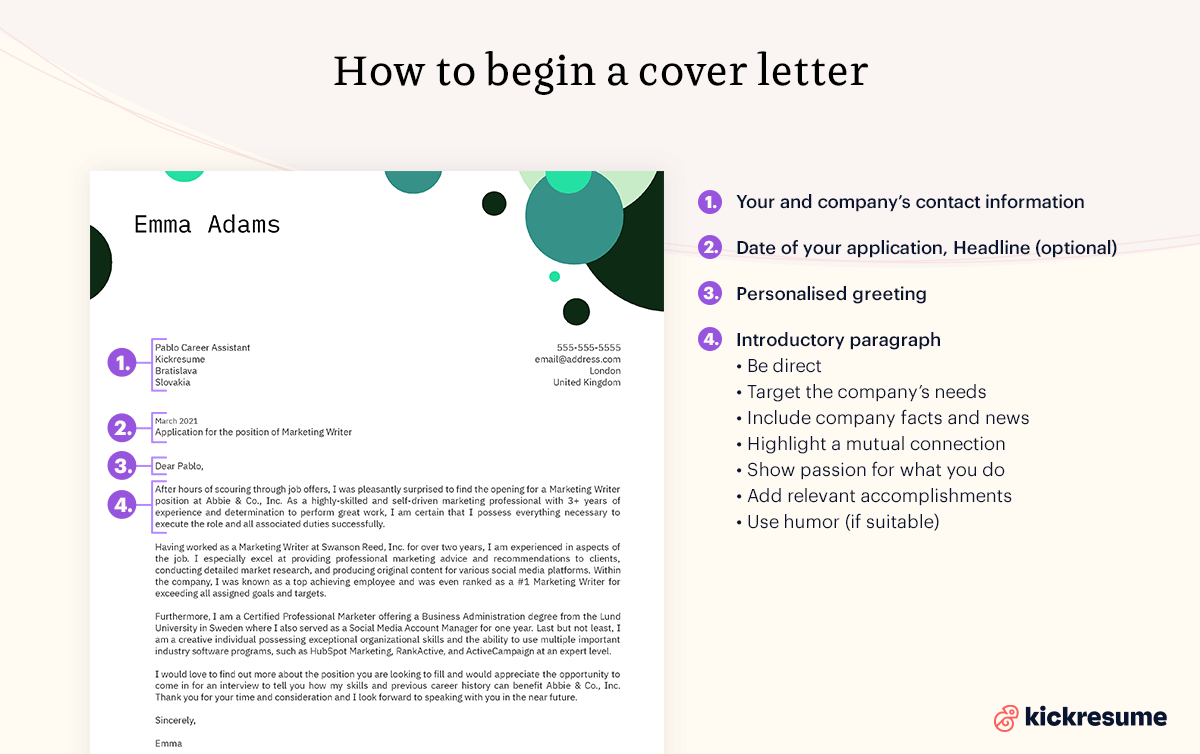
1. Be direct
Employers are busy people who usually don’t have time to read long texts or overused cover letter phrases . What they want to know is simply whether you’re a good fit. Why not make it easier for them and be specific from the very beginning?
Let them know what position you’re applying for and use your cover letter opening to highlight years of experience in your field and any relevant hard or soft skills you bring to the table.
It’s a universal, yet effective answer to how to start a cover letter.
Cover Letter Intro Example #1
I am very interested in the Sales Specialist opportunity at [Company XYZ] that was advertised on LinkedIn. I am a hard-working and dedicated individual with over two years of extensive industry experience, a Business & Management degree from McGill University, and a strong determination to meet and exceed all business goals and objectives.
2. Respond to the company’s needs
Employers want to know how you can contribute to their company. The first paragraph of the cover letter is a great place to demonstrate that.
Have a look at the job offer, go over the company’s needs, and pick those that you can easily relate to.
Then take a look at your achievements and impressive skills, and use them to illustrate how you can bring value to the new job. Ideally by mentioning any quantifiable results from your previous jobs.
Cover Letter Intro Example #2
Over the course of last year, I more than doubled [Company XYZ]’s Twitter followers and ran two successful Instagram ad campaigns that generated $35K+ in revenue. I’d love to bring my expertise in organically expanding the social reach and delivering ROI to the social media manager position at [Company XYZ].
3. Include company facts and news
Companies want to see that you’re interested in them and their industry. If you show that you already know about them and have done your research, you can make a great first impression.
Browse their website and scour the internet for related news articles. They can provide you with interesting facts that pertain to your role.
It can be anything — a specific event, fact, notable statistic, or an award that the company has recently received.
Cover Letter Intro Example #3
When I saw that [Company XYZ] was featured in Fortune Magazine last month for its commitment to renewable energy and reducing waste in the workplace, I was truly inspired. With my track record of reducing costs by over 30% and promoting sustainable technologies, I’m excited about the opportunity to take on the account executive role to expand your company’s growth and work towards a greener future.
4. Highlight a mutual connection
Referrals can work like magic when it comes to getting invited to a job interview . So if someone has recommended you for a position or you know anyone at the company who can vouch for you, mention their name right away.
After reading your cover letter, recruiters will most likely want to learn why your referrer thought you’d be a good fit. If nothing else, it will make recruiters pay attention to the rest of your cover letter.
Cover Letter Intro Example #4
I was excited to learn of this job opportunity from my former colleague, Lucy May. We’ve worked closely together for several years, most recently on a complex data analysis project at [Company XYZ]. She advised me to apply as she thought I’d be a good match for this position on your team.
5. Show passion for what you do
Employers love job candidates who are enthusiastic about what they do. These candidates tend to perform better and are more dedicated to their roles.
So if you’re all hyped up about your job, don’t hesitate to infuse your cover letter with a couple of sentences demonstrating your excitement about what you’re doing.
Cover Letter Intro Example #5
I knew I had a knack for writing ever since I was the main editor of our high school magazine. Thanks to my 15+ years of experience, I’ve transformed my passion into a fashion blog with 30K+ monthly readers, featured articles on Time and Cosmopolitan that have garnered over 50K views, and a writer’s workshop I founded for young up-and-coming writers.
6. Open with a relevant accomplishment
Hiring managers like achievers. If you’ve accomplished something noteworthy while with your previous employer, there’s a good chance you can bring the same value to your next job too.
What’s more, it shows that you’re an expert in your field.
If you have any special skills or accomplishments that will make you stand out from other job candidates, mention them right away in your cover letter opening.
However, try to make no general claims without providing evidence. Support your arguments with real numbers and statistics.
Cover Letter Intro Example #6
Over the past year as digital marketing manager at [Company XYZ], I’ve generated $50k+ in revenue, increased organic traffic to our blog by 18%, and almost tripled our social media ROI.
7. Use humor and creativity
Recruiters are human beings, too (shocking). In a pile of boring resumes and repetitive cover letters and motivation letters , they may find a good joke, juicy pun, or funny opening line a nice refreshing break.
It can even be a reason to call you up for an interview.
So if the company seems to have an easygoing vibe, use humor to bring attention to your skills or relevant personal traits that are needed for the position you’re targeting.
Cover Letter Intro Example #7
Before I flood you with all the reasons why I’m going to be your next writer, I would like to tell you a little about myself. I didn’t learn to hold a pencil until I was about six years old, which made everyone think I’d never pen a single letter. And now here I am, bidding to become your next Shakespeare.
Cover letter beginning: What other things to include?
Now that you saw some great examples of cover letter openings, you may wonder what else can you do to perfect your cover letter introduction.
Well, there are a few other key elements that a good cover letter beginning should include:
- contact information both for you and the company
- headline (optional)
- personalized greeting
To know where to put this information, just scroll down.
Header
This is the place for your and your company’s contact information.
Make sure that right at the top of the page you list your contact details such as:
- full name
- phone number
Optionally, you can also include:
- your professional title
- address
- date of birth
- current date
- personal website/LinkedIn
Additionally, never forget to add company-related information. You should always include the manager’srecruiter’s name (if it was made available to you), job titledepartment, the name of the company, and their address.
Left align all of this information. Or make it easy for yourself and choose a pre-designed cover letter template and only fill in the details.
Headline (optional)
You don’t have to include it, but it can help you grab the hiring manager’s attention.
In your cover letter headline, you can use numbers, questions, or interesting adjectives.
It can be something like “5 Ways I Can Help You Improve Your Company’s Marketing.”
Alternatively, you can just state the name of the position you’re applying for.

Salutation (or how to address a cover letter)
Try to avoid using “To Whom it May Concern” or “Dear Sir/Madam”. This form of address, while correct, has become so overused it won’t help you stand out at all.
Instead, try to research the hiring manager’s name online. Look at the job posting, and check the company’s website or LinkedIn. (Did you know that you can turn your LinkedIn profile into a great resume with just one click?)
Alternatively, you can address it to the whole team or HR.
Generally, stick to these rules:
- How to address a cover letter to a recruiter or hiring manager: The best practice is to use a personalized greeting in the following form: “Dear [first name]” or “Dear Mr./Mrs. [last name]” for formal companies.
- How to address a cover letter to multiple recipients: If you’re addressing your cover letter to the entire team or human resources, you can use “Dear [name of the company/department] Team” or “Dear Human Resources”.
- How to address a cover letter to an unknown person: If you fail to find the hiring manager’s name and don’t want to address your cover letter to an entire team or HR, use “Dear Hiring Manager”, or “Dear Recruitment Officer”.
After the salutations, you can continue with an attention-grabbing intro paragraph.
HR expert tip: Christy’s word of advice
“In general, a traditional formal cover letter is the safest bet. But there are times when you can totally throw that advice out the window and have a bit of fun putting your personality on paper! Take a look at how the company brands its ‘voice’ on its website and in the job description. Do they sound relaxed and personality-driven? Is formality anathema to them? If yes, don’t be afraid to reciprocate (while still keeping it professional). After all, you’re not just applying for a job: you’re applying to be part of the company’s culture”. — Christy Morgan, Resident HR Expert
Key takeaways: How to begin a cover letter
To sum up — the beginning of your cover letter will determine whether the hiring managers will read the rest of it or not.
If you want them to pay attention to what you have to say, make sure your cover letter opening:
- Uses a personalized greeting
- Says who you are
- Shows you’re passionate about the job or the company
- Highlights your top (and relevant) accomplishments and skills
- Mentions a mutual contact
- Reflects the company’s tone of voice
- Is tailored to a specific position and company’s needs
- Uses keywords from the job description
- Is short, nice, and direct
Of course, the rest of your cover letter is important too.
If you’d like to know what to write in the rest of your letter, check out our complete cover letter guide, get inspired by cover letter examples, or learn how to end a cover letter .
This article was recently updated. The original article was written by Nikoleta Žišková in 2021.


![How to Write a Professional Resume Summary? [+Examples]](https://d2xe0iugdha6pz.cloudfront.net/article-small-images/i-Profile.svg)
![How to Put Your Education on a Resume? [+Examples]](https://d2xe0iugdha6pz.cloudfront.net/article-small-images/i-Collage-Universities.svg)
![How to Describe Your Work Experience on a Resume? [+Examples]](https://d2xe0iugdha6pz.cloudfront.net/article-small-images/Experience.svg)


